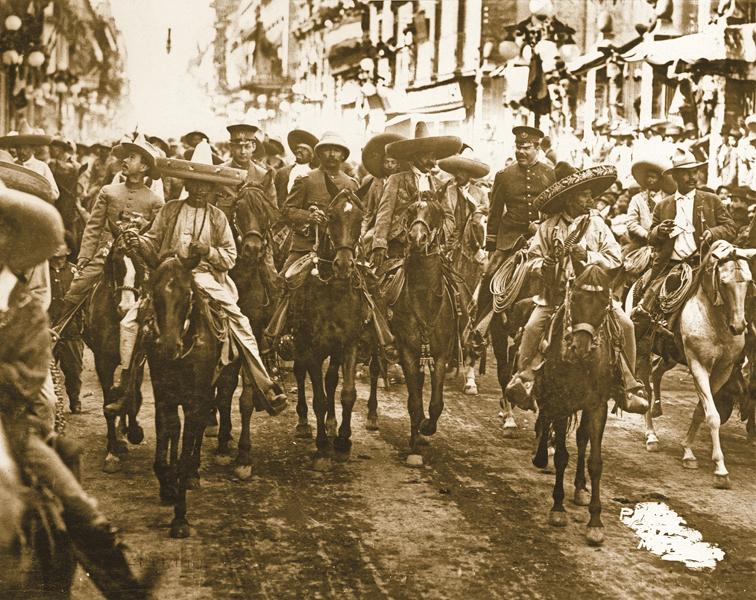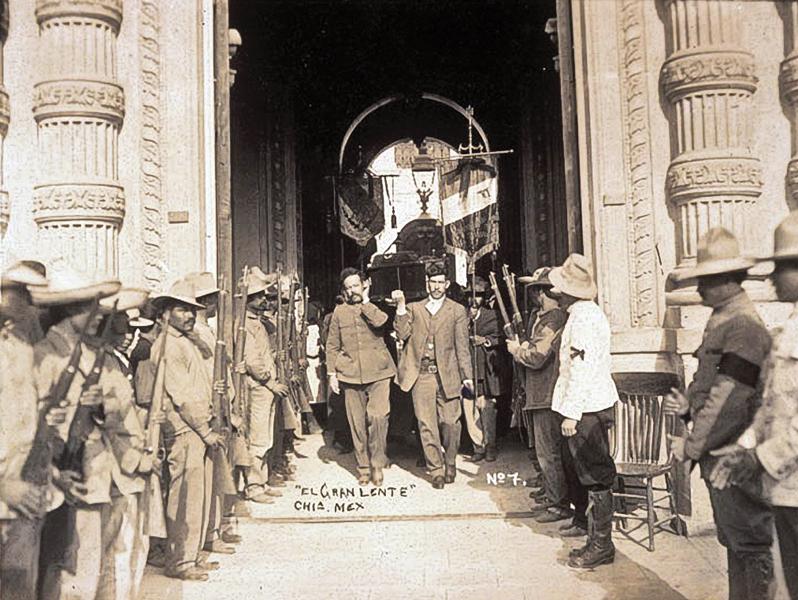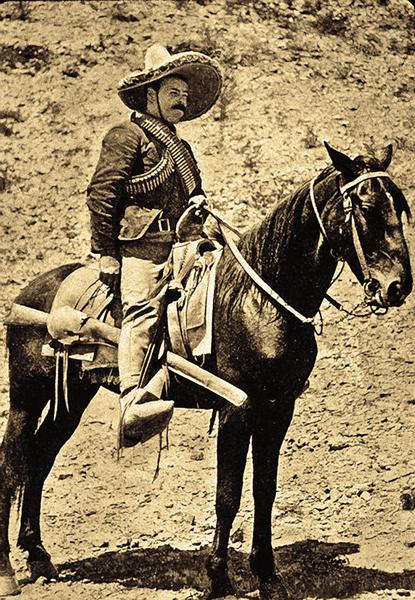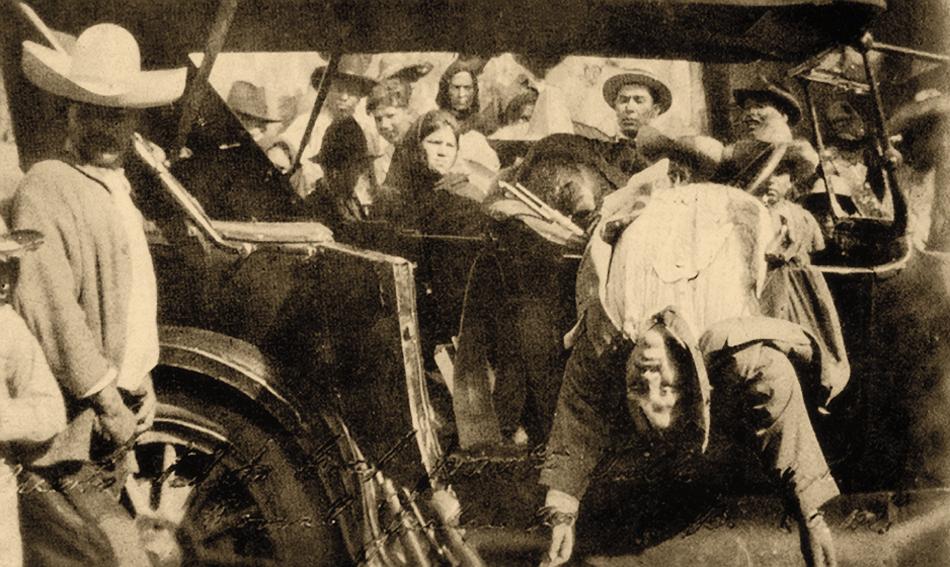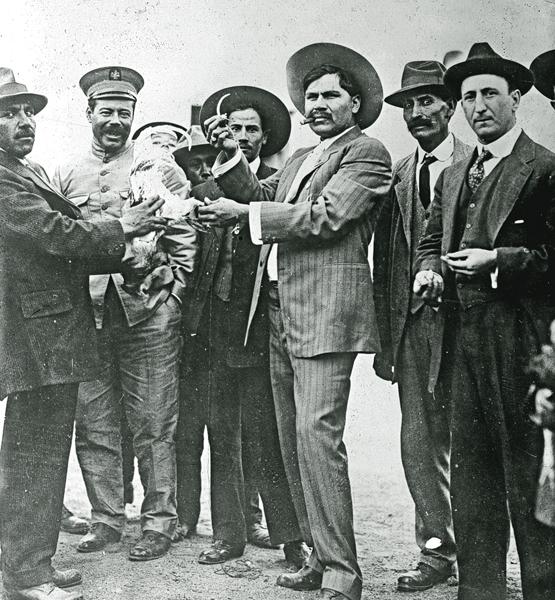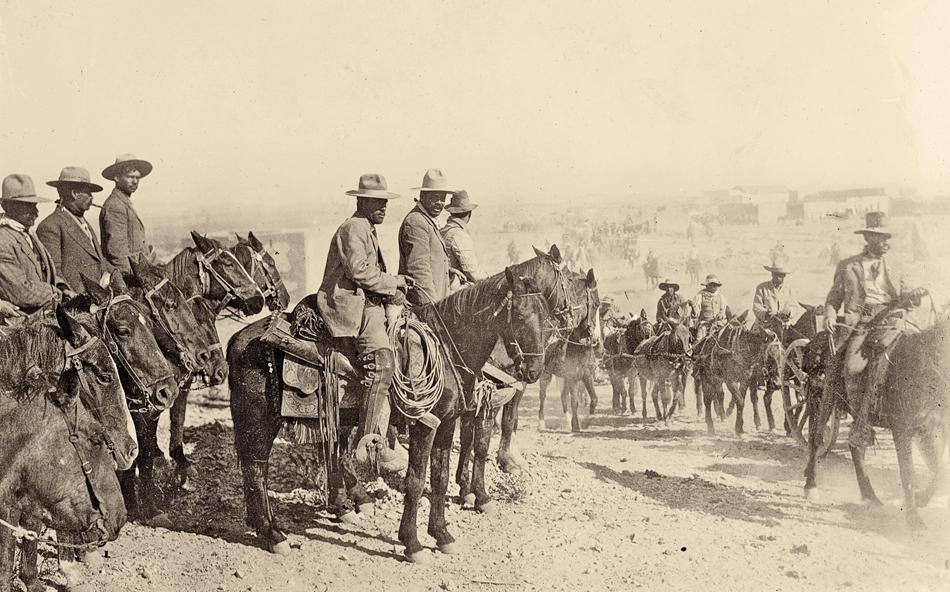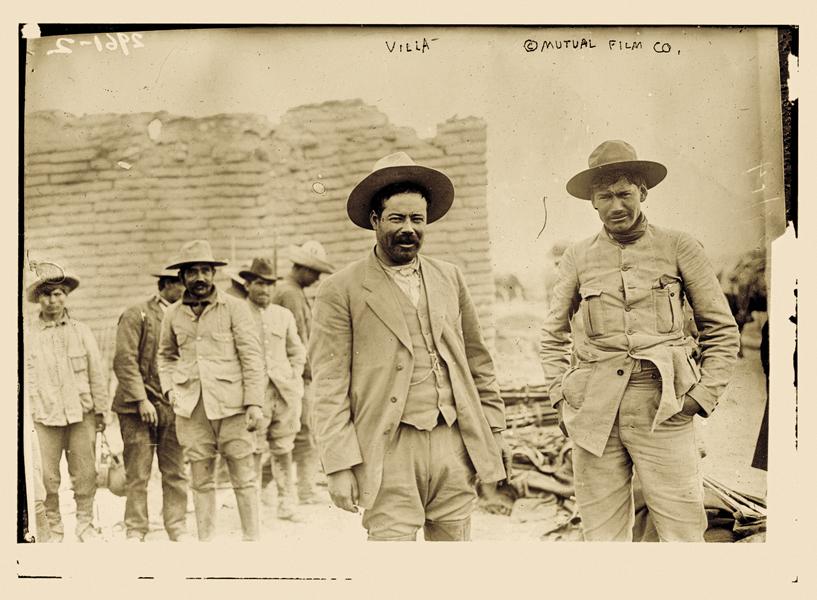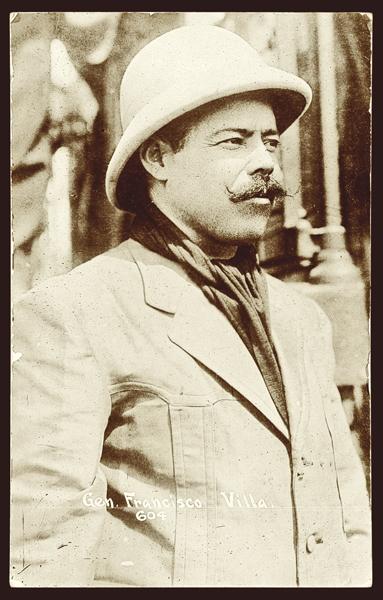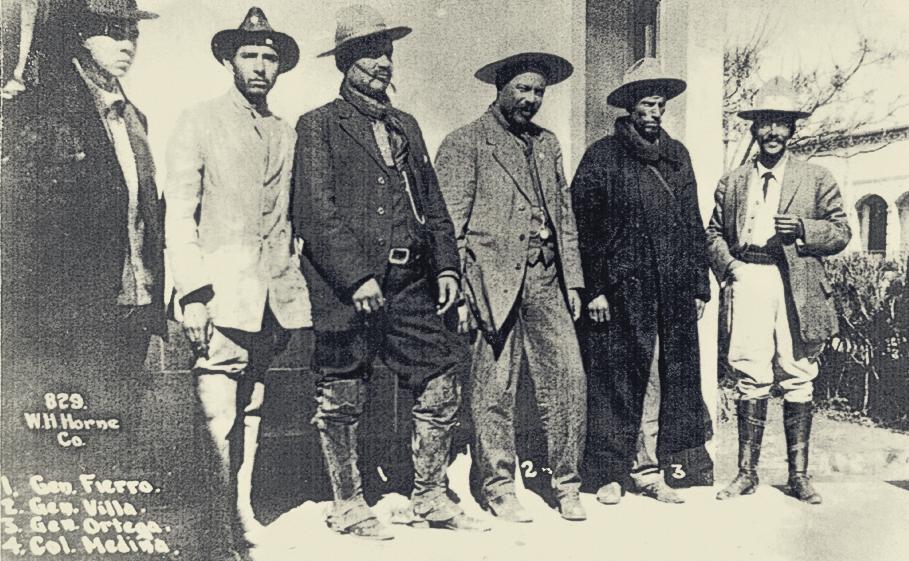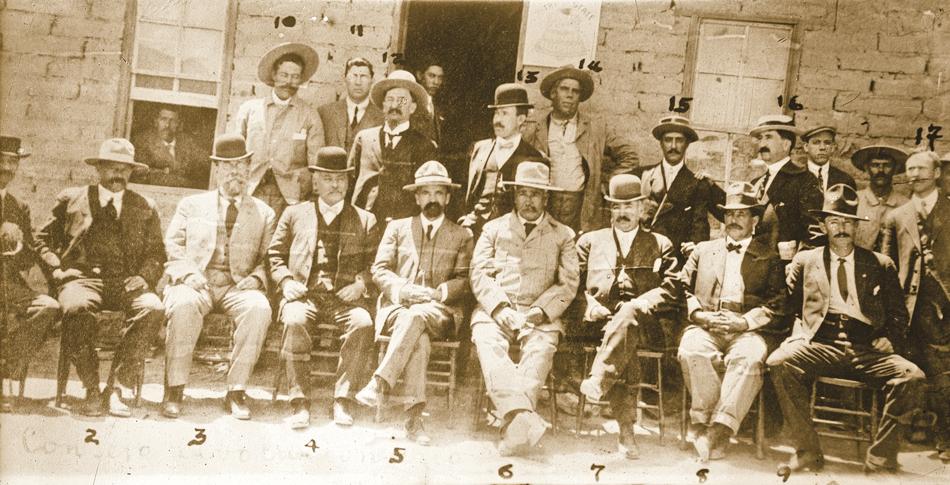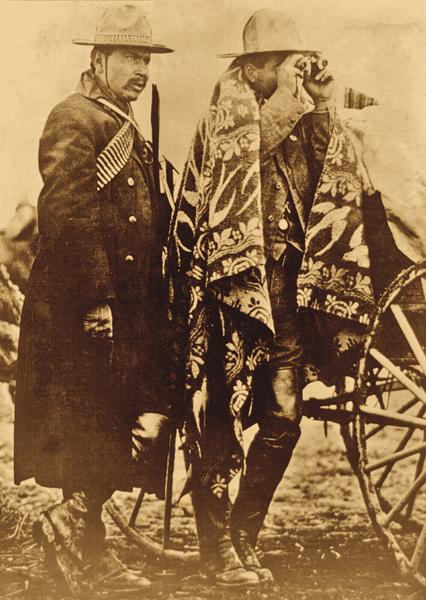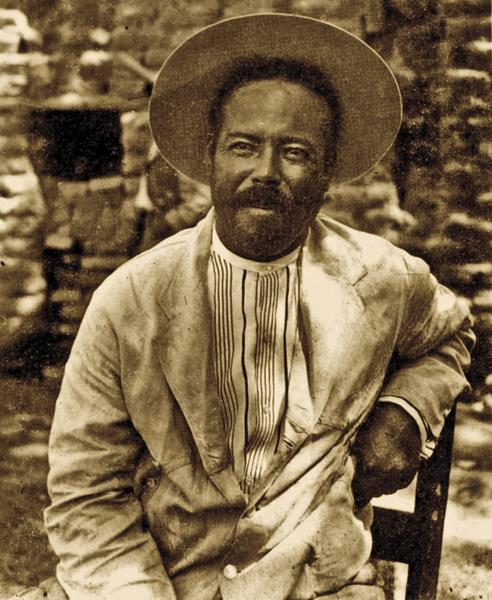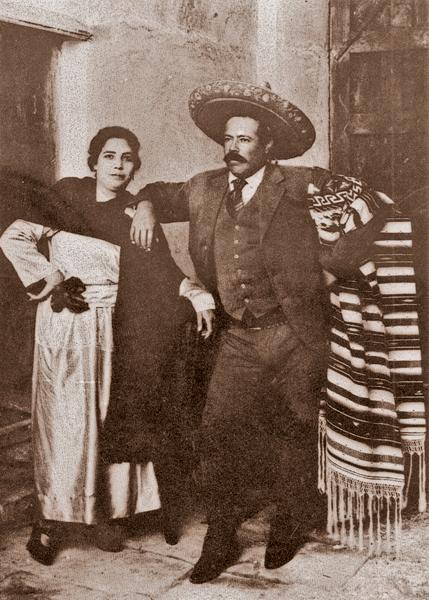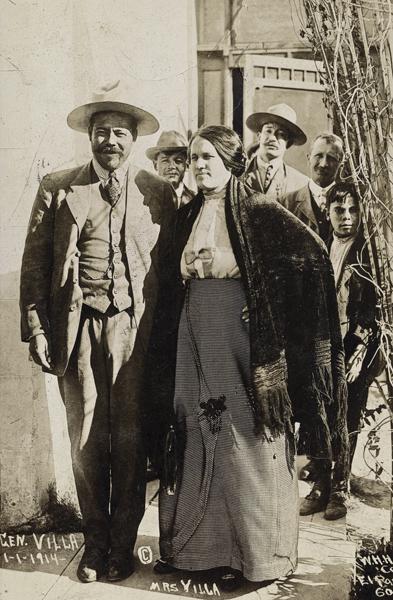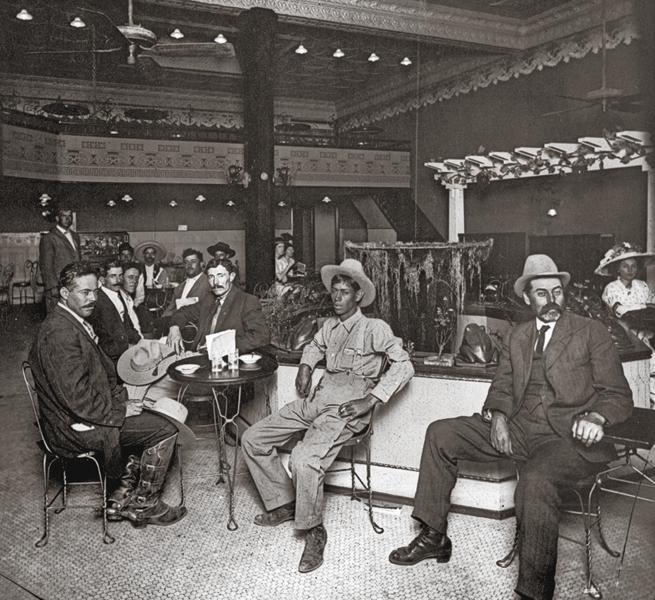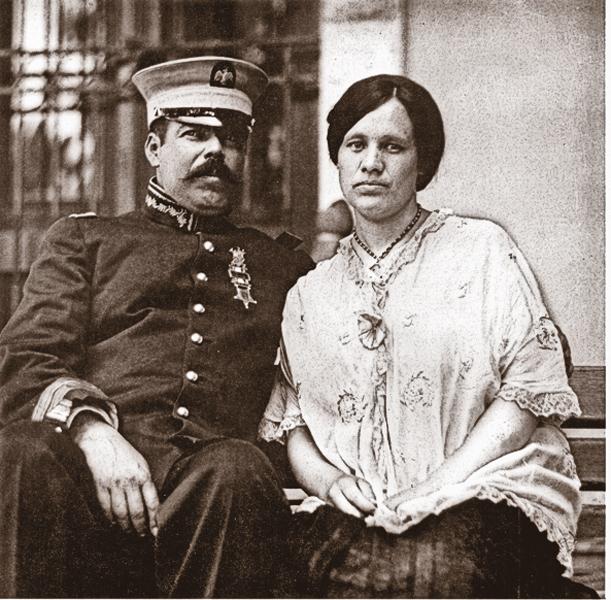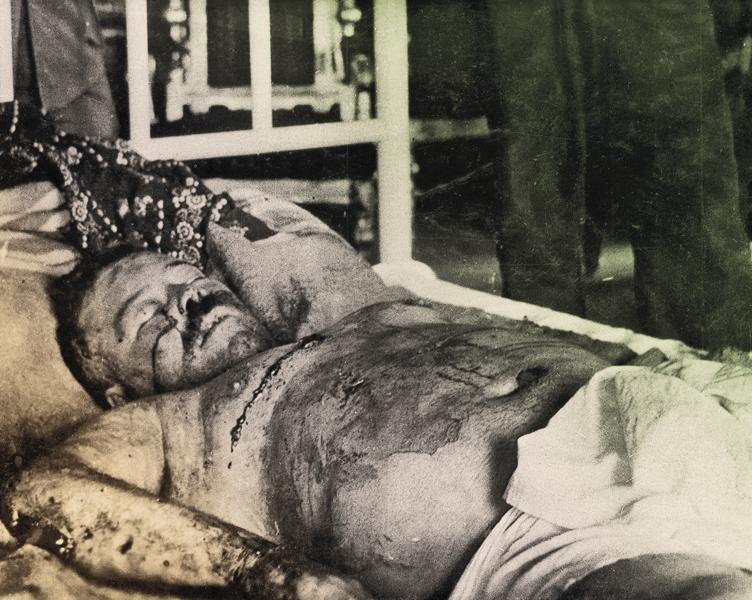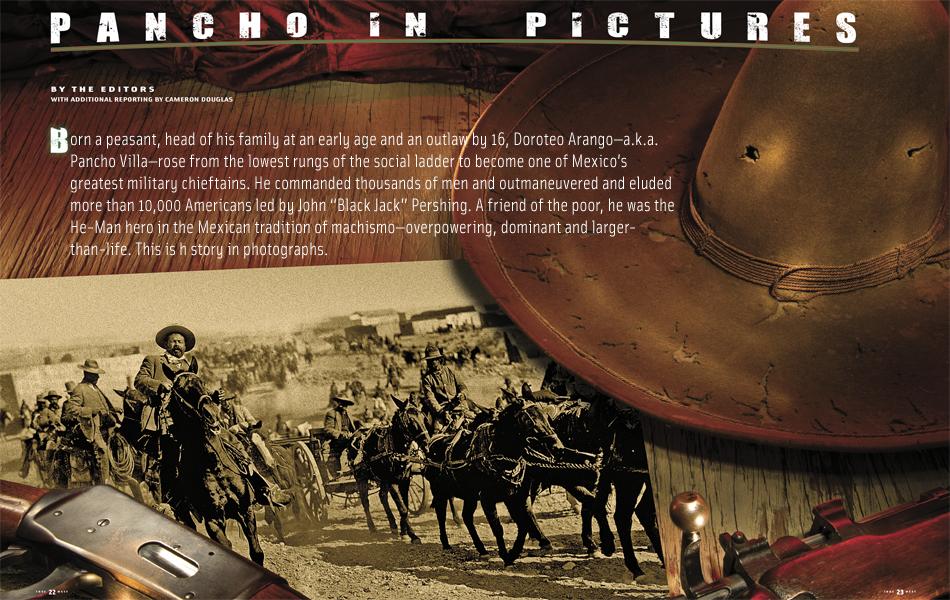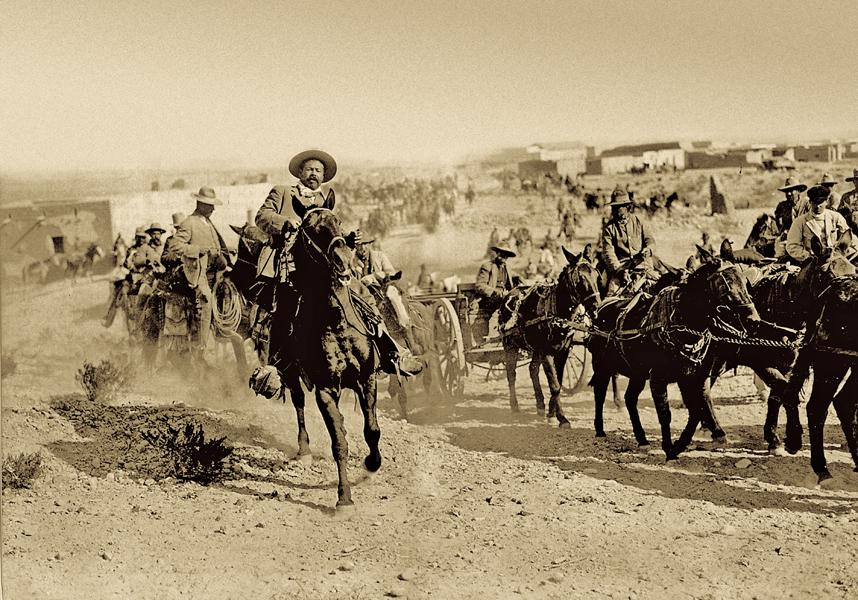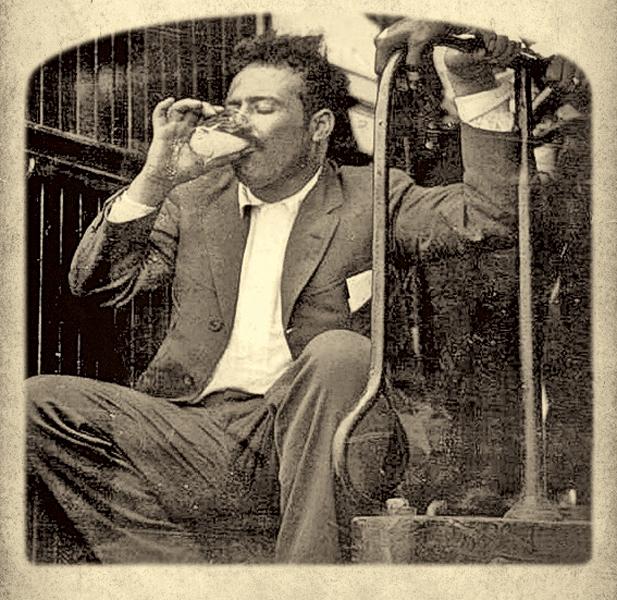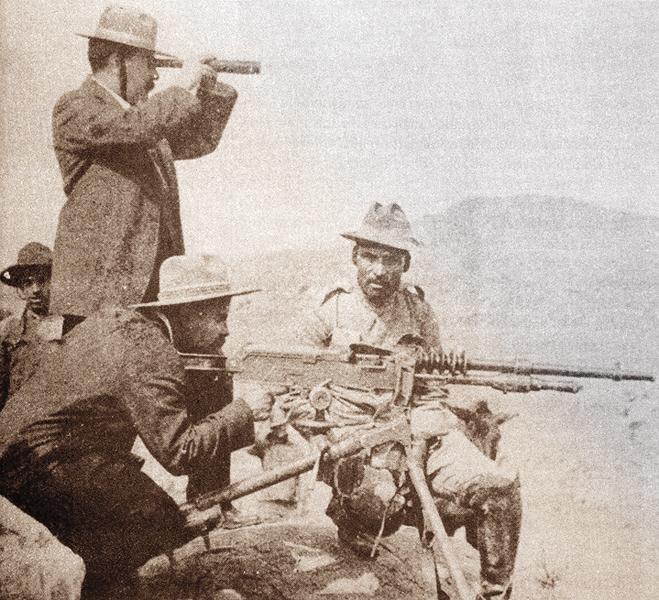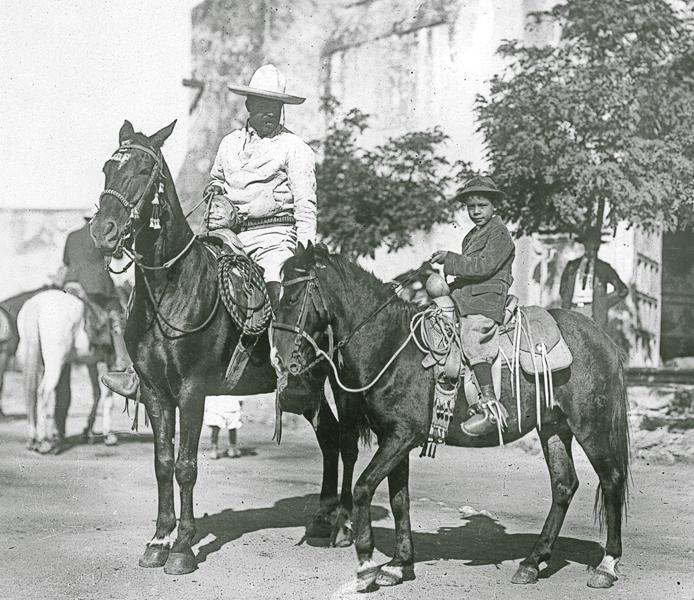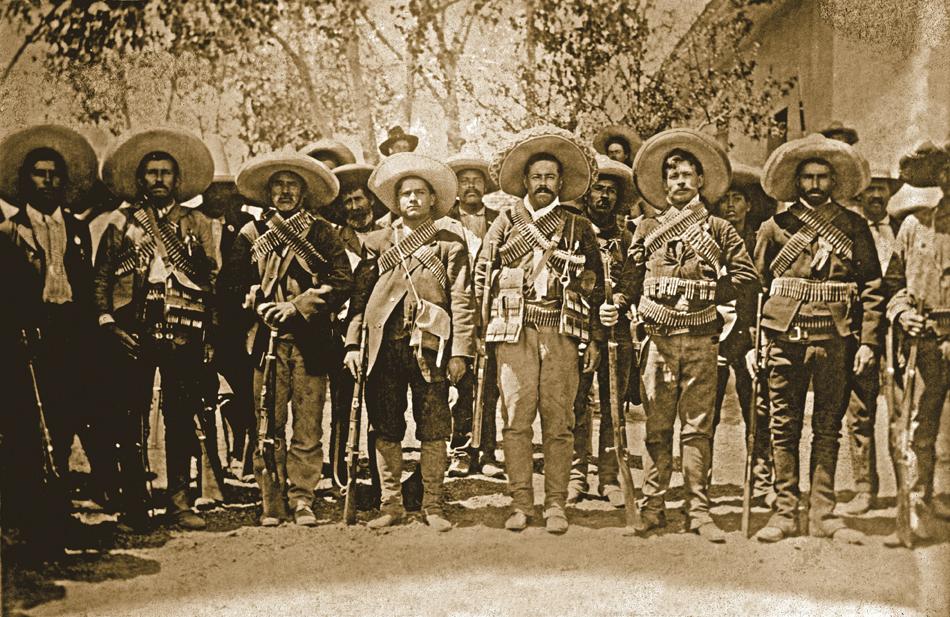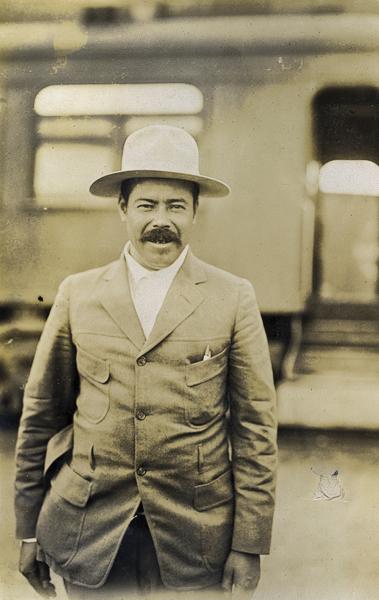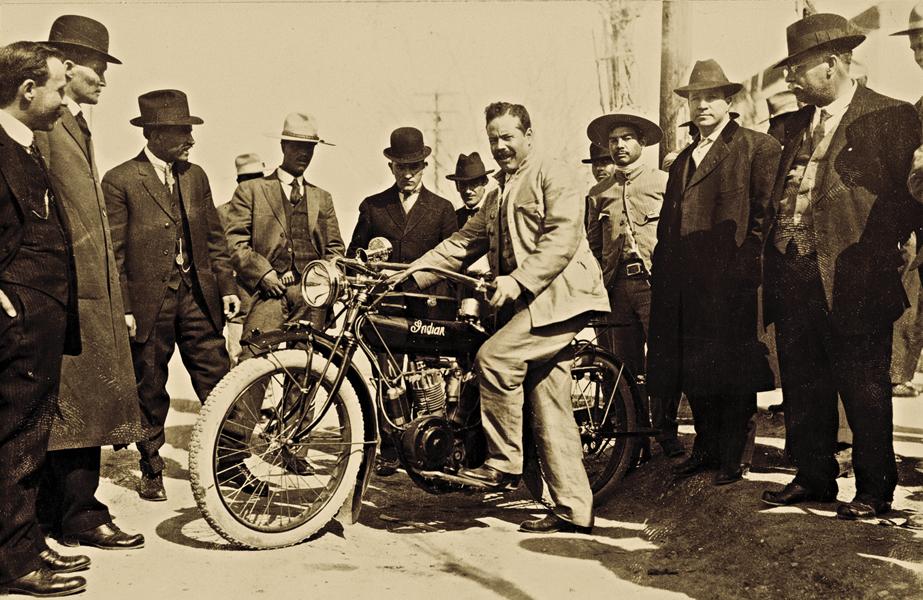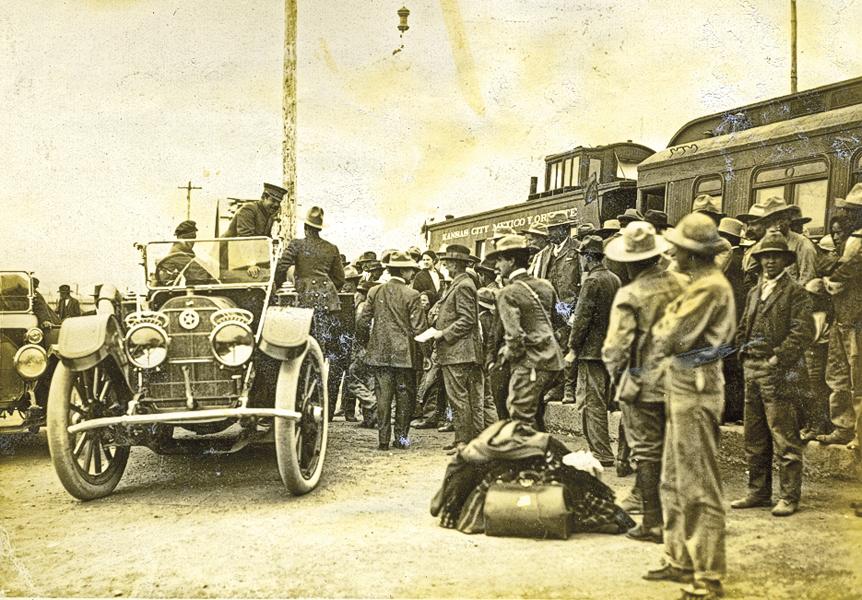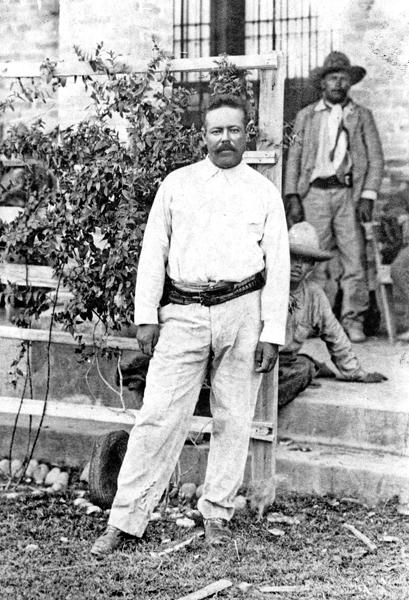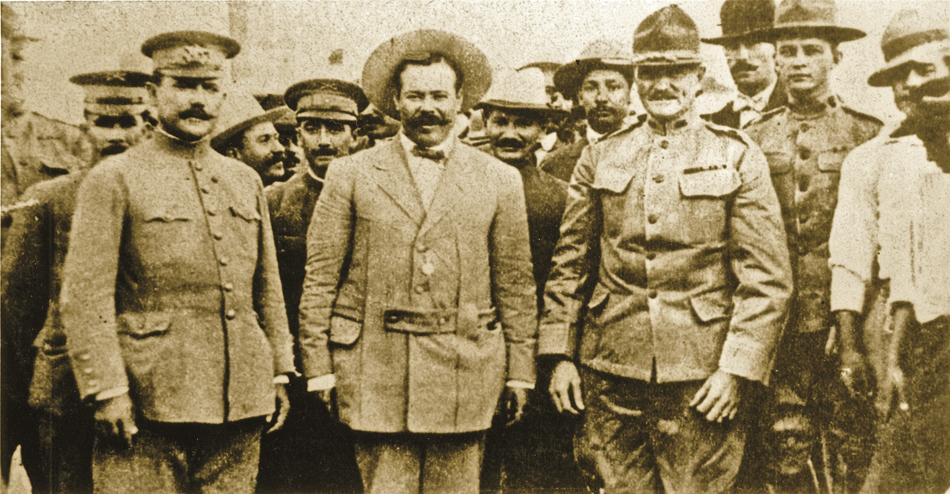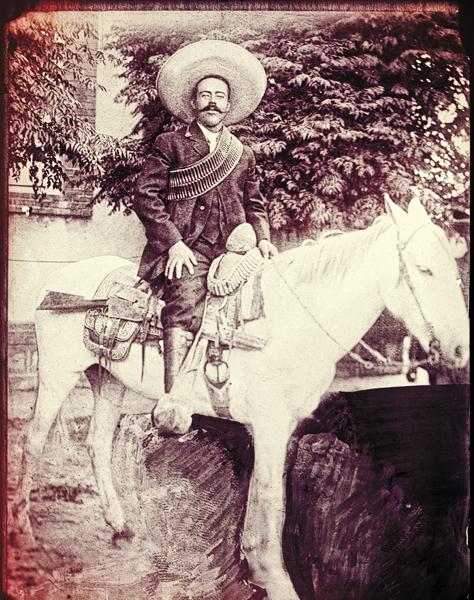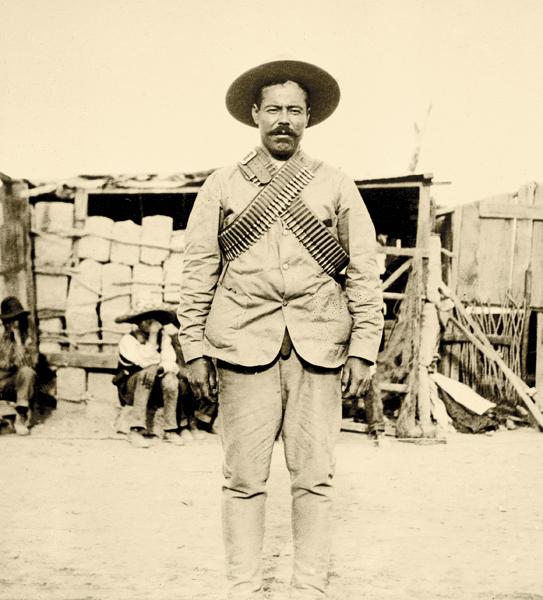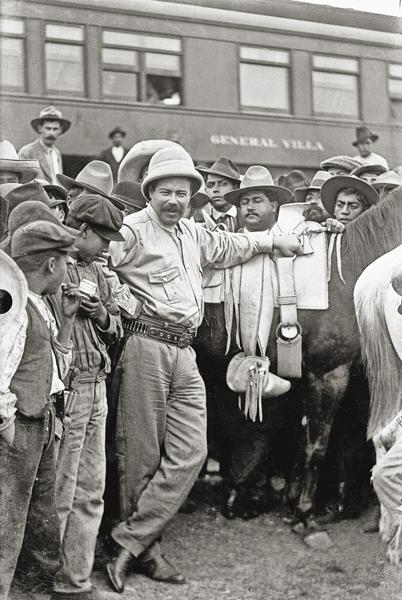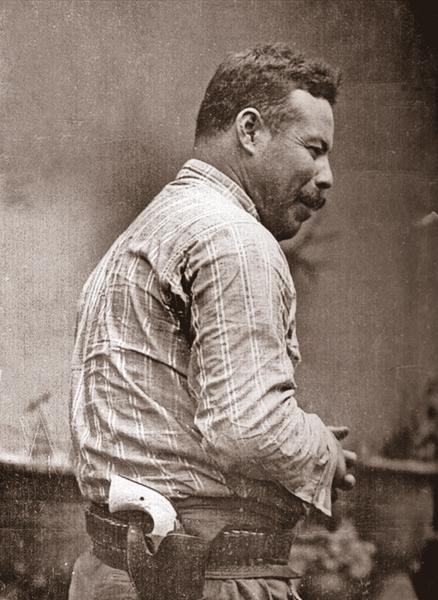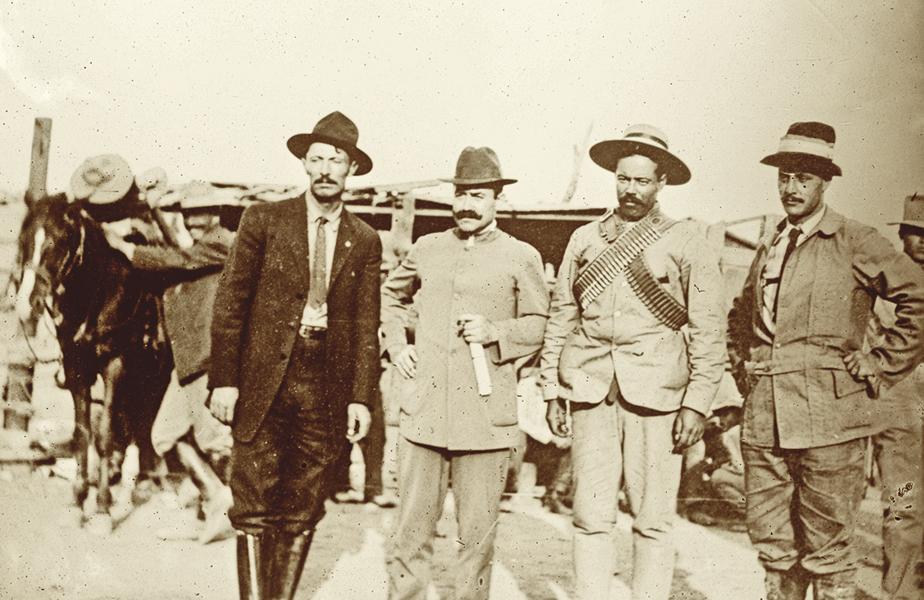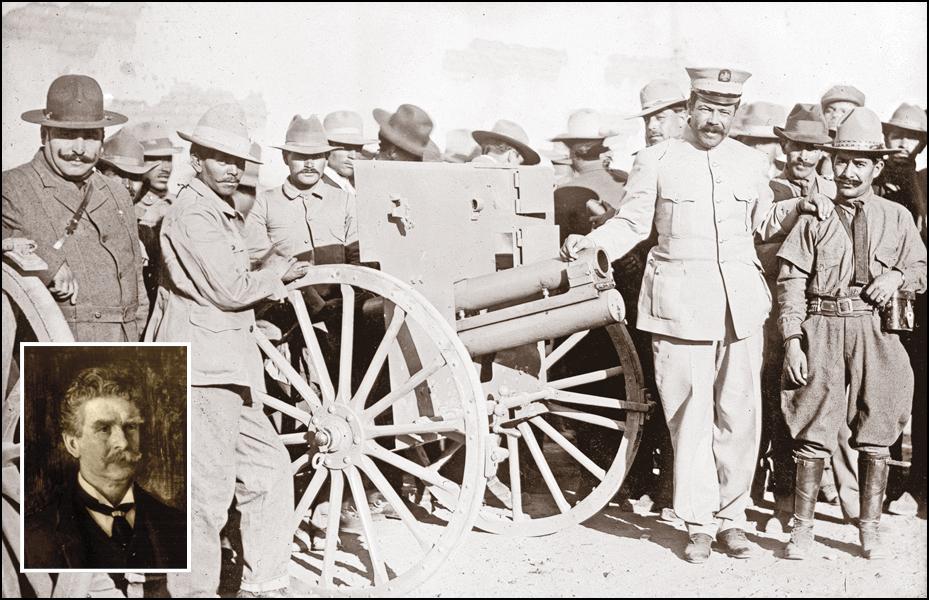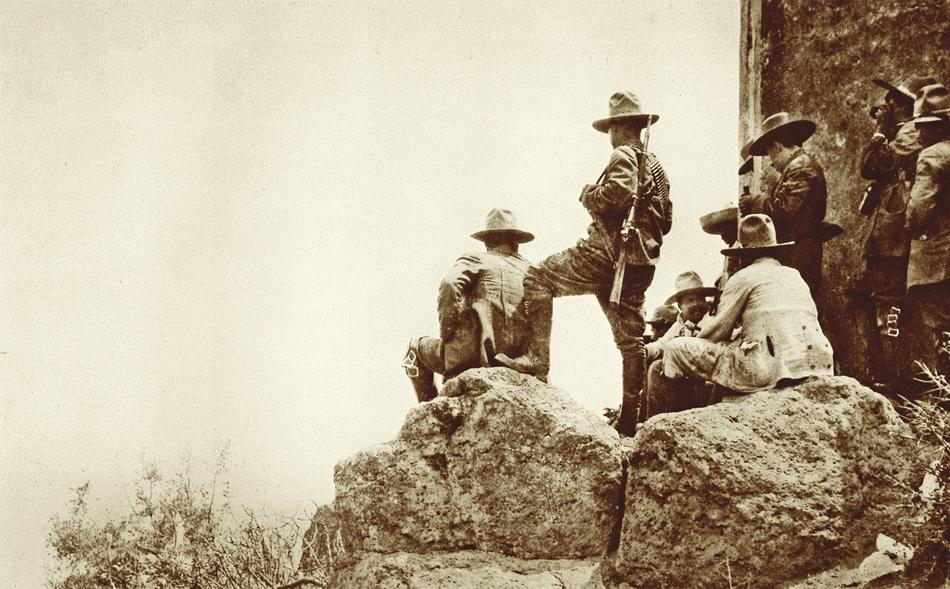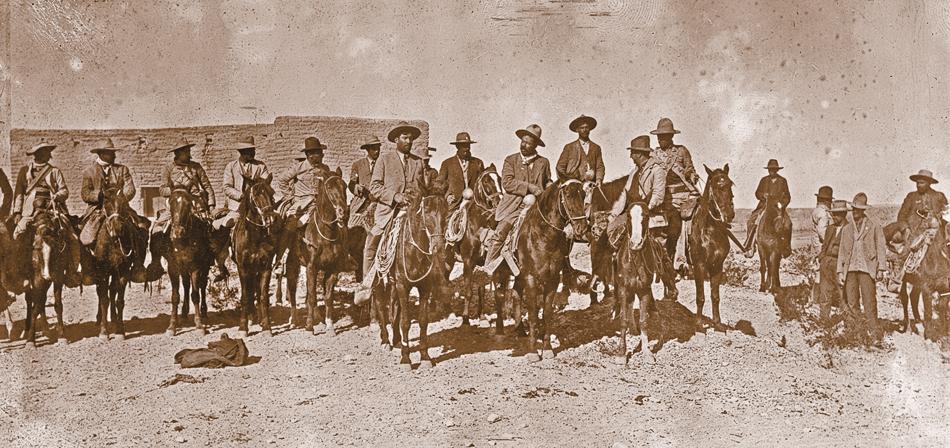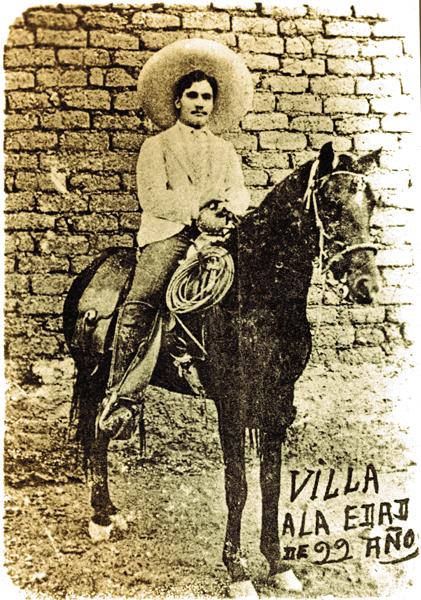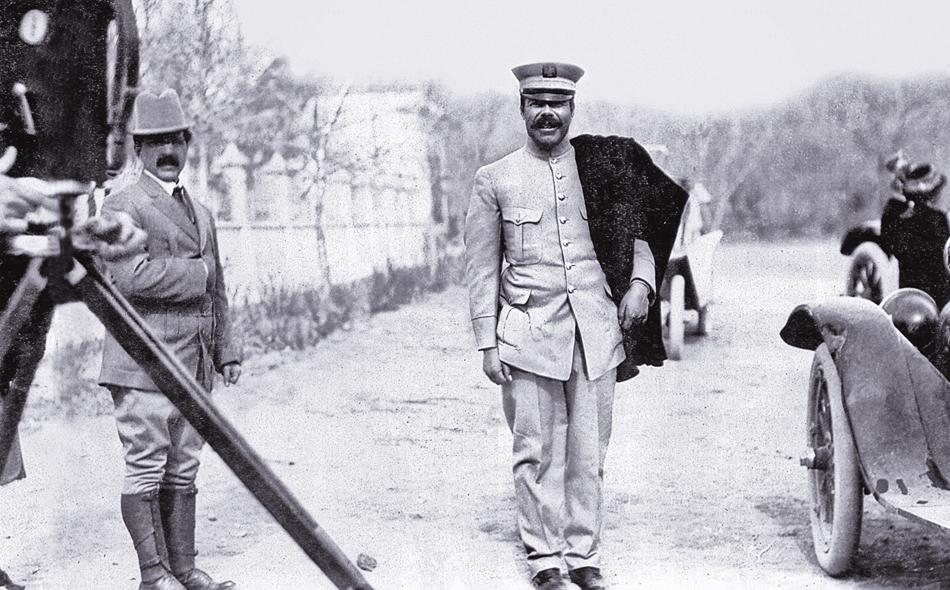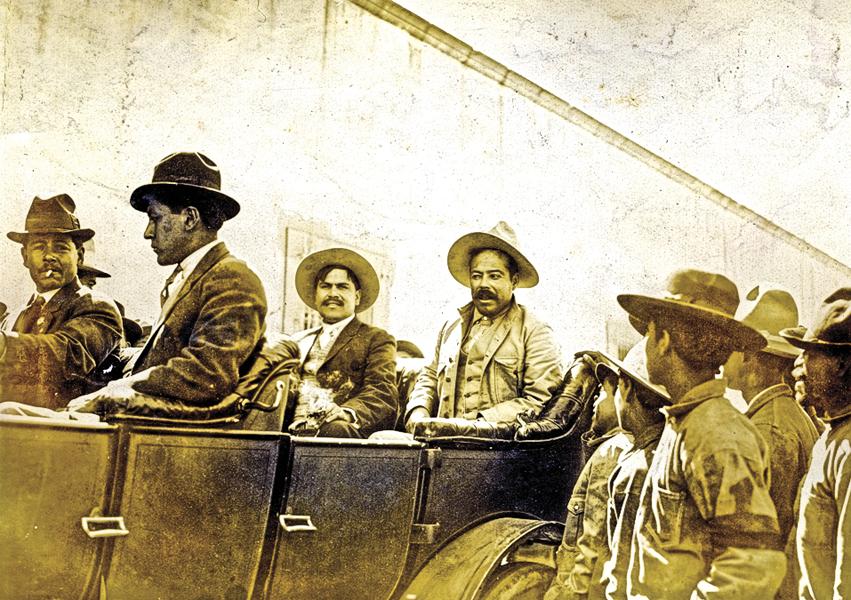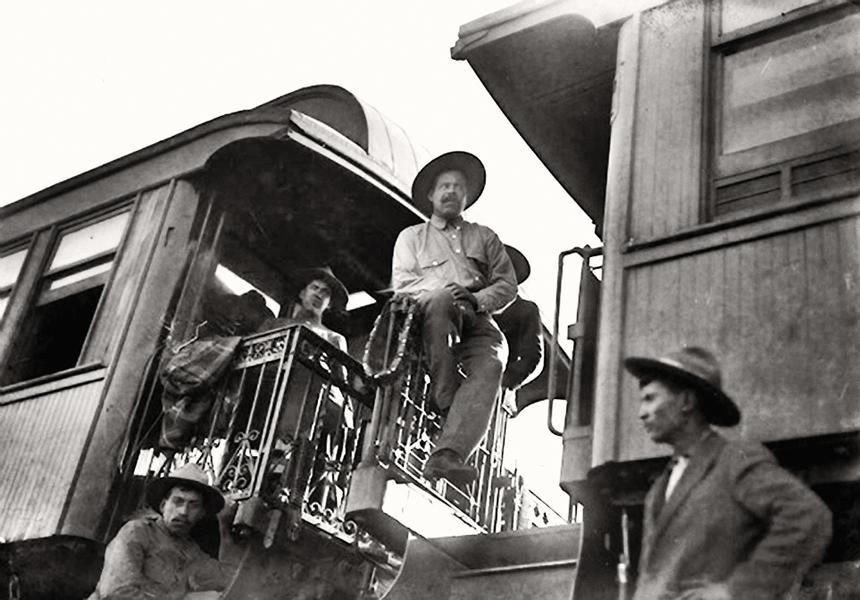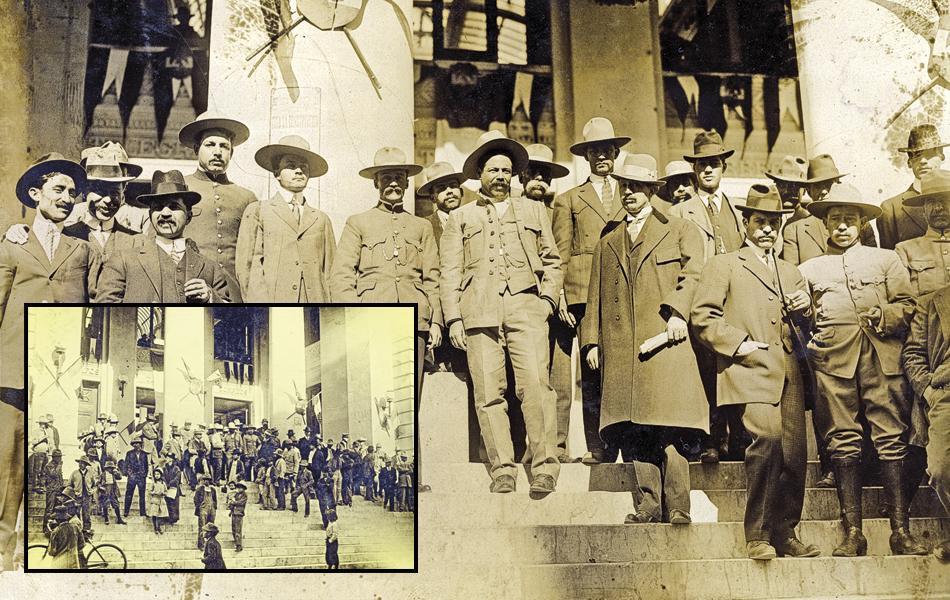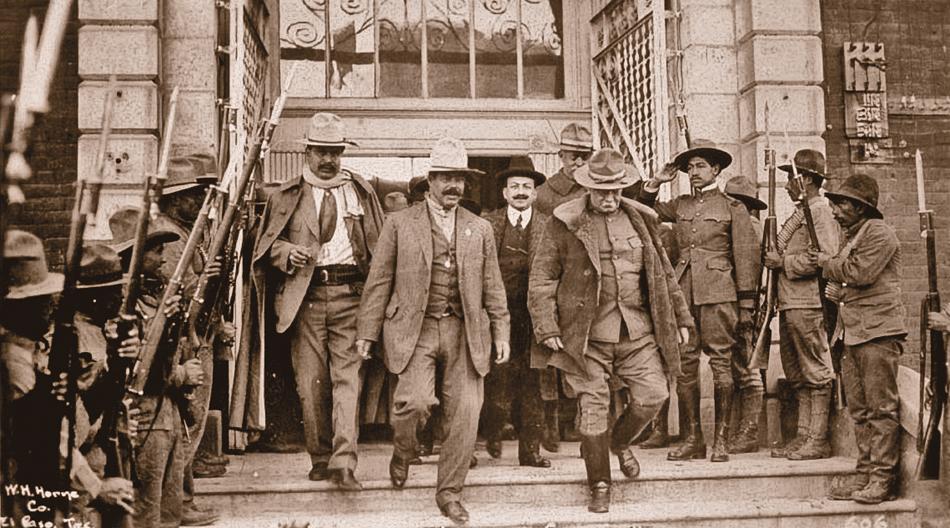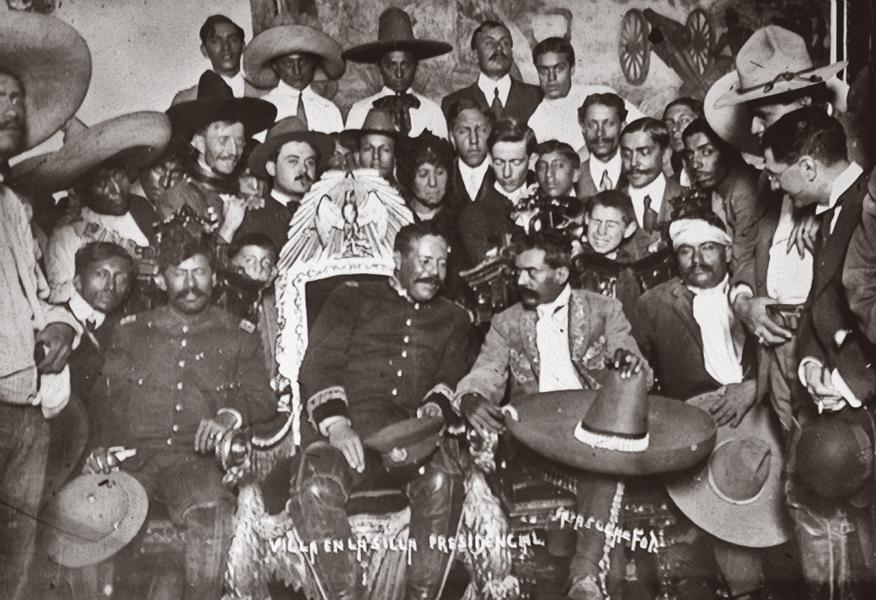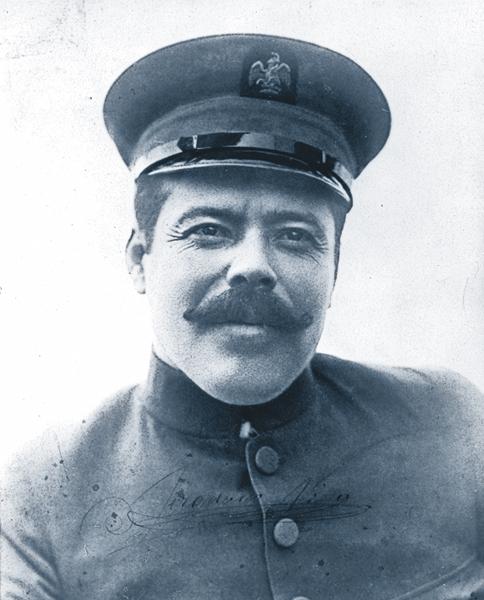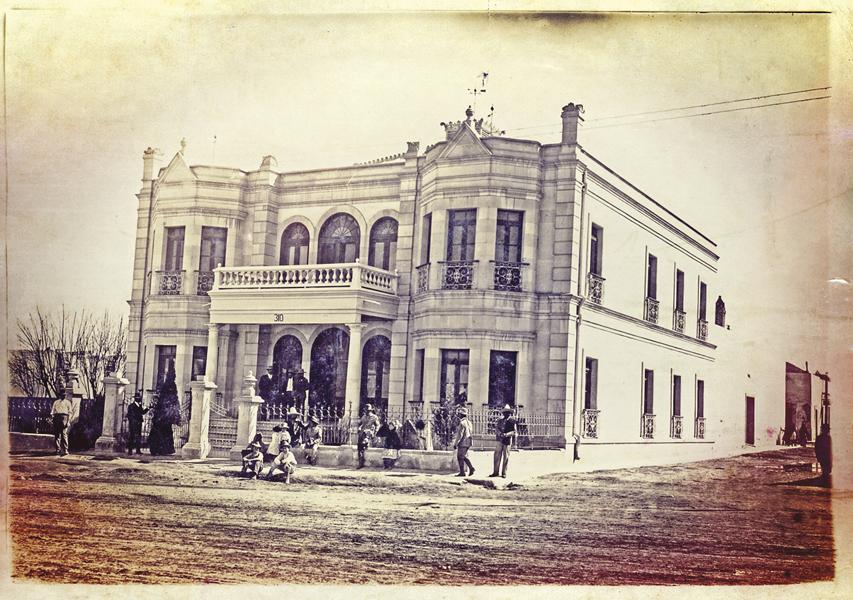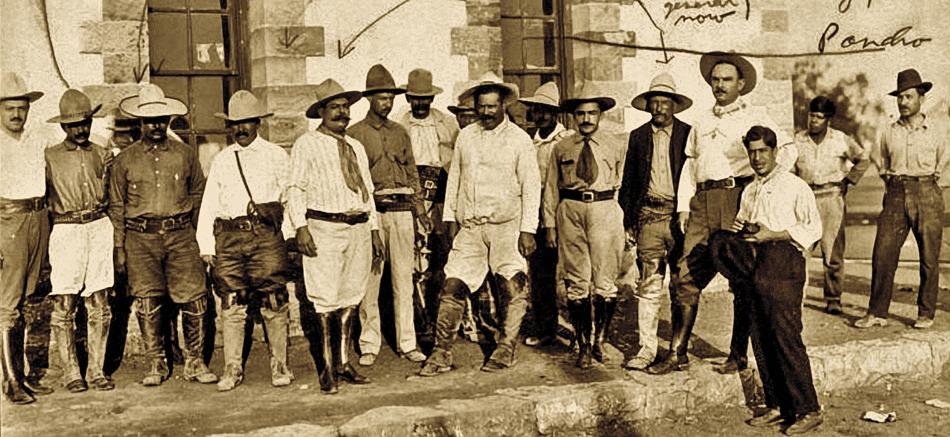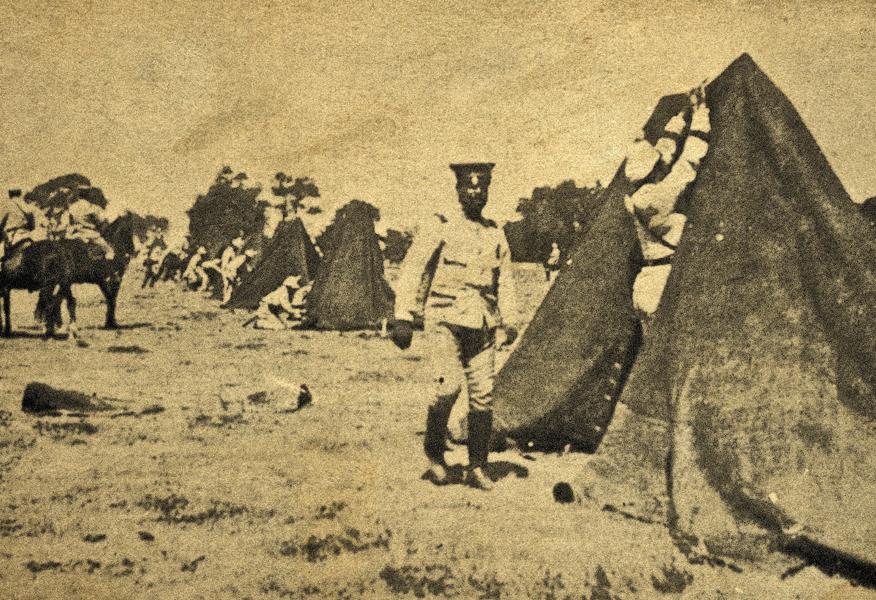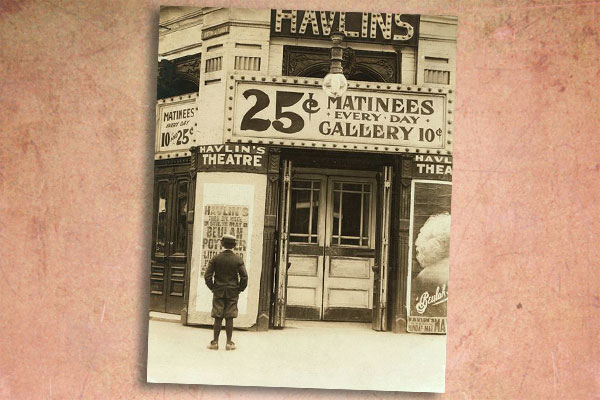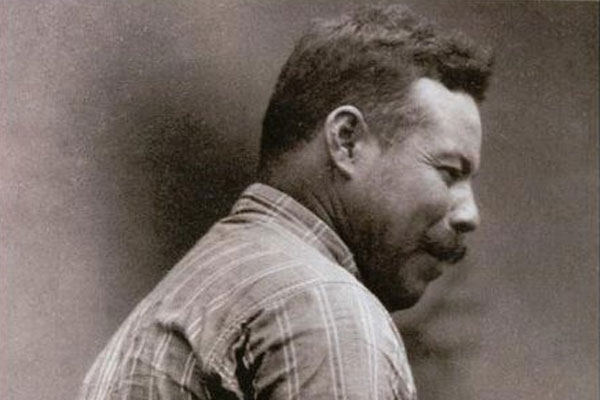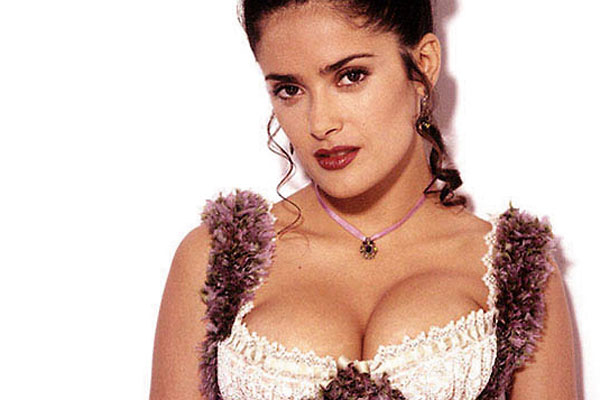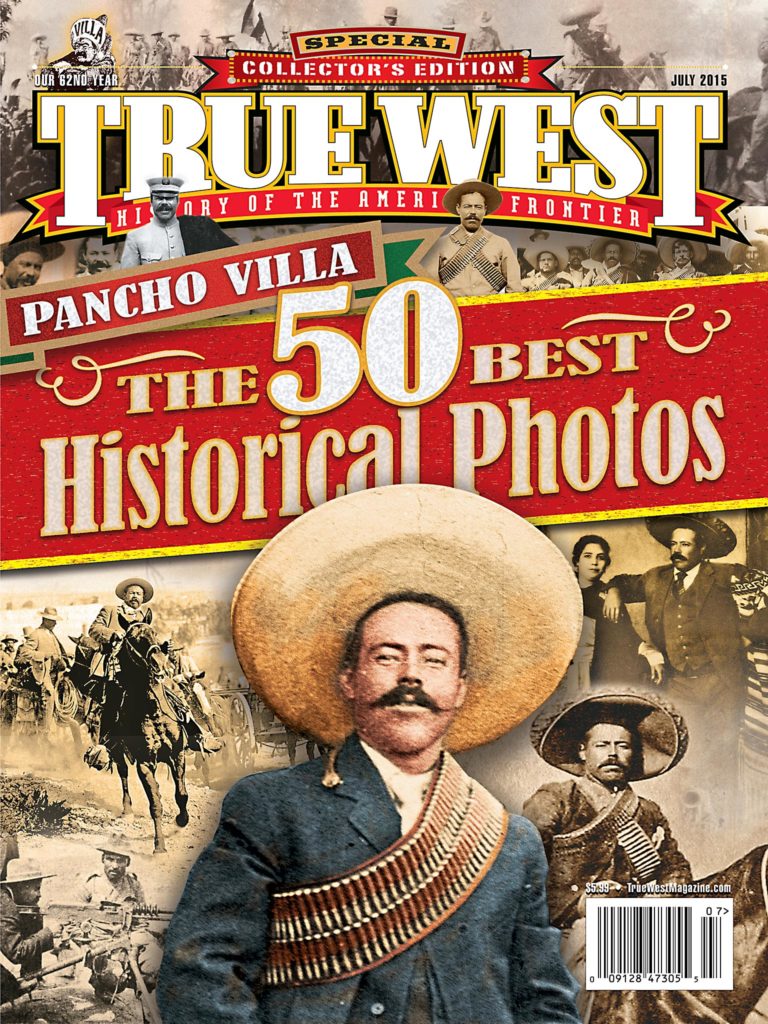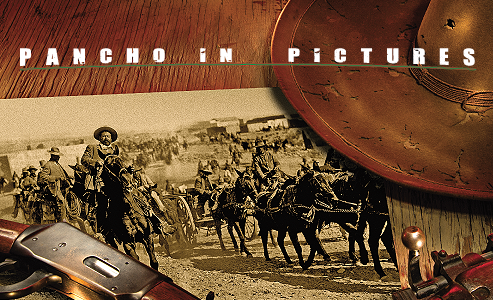 Born a peasant, head of his family at an early age and an outlaw by 16, Doroteo Arango—a.k.a. Pancho Villa—rose from the lowest rungs of the social ladder to become one of Mexico’s greatest military chieftains.
Born a peasant, head of his family at an early age and an outlaw by 16, Doroteo Arango—a.k.a. Pancho Villa—rose from the lowest rungs of the social ladder to become one of Mexico’s greatest military chieftains.
He commanded thousands of men and outmaneuvered and eluded more than 10,000 Americans led by John “Black Jack” Pershing. A friend of the poor, he was the He-Man hero in the Mexican tradition of machismo—overpowering, dominant and larger-than-life. This is his story in photographs.
Photo Gallery
On December 6, 1914, Pancho Villa entered Mexico City in full military uniform, which may be the costume Hollywood had him wear for the film The Life of General Villa. Behind the buglers, from left, are eventual-President of Mexico Gen. Abelardo L. Rodríguez, Gen. Tomás Urbina, Gen. Emiliano Zapata (wearing a sombrero), Gen. Pancho Villa and Villa’s infamous butcherer Rodolfo Fierro. Whereas Villa commanded revolutionary forces in northern Mexico, Zapata commanded those in the South. Both leaders eventually went down in flames: In 1919, Zapata was assassinated, while Villa suffered the same fate in 1923.
– Courtesy Chet & Lindy Downs –
Because of Abraham González, Pancho Villa became convinced that he could ”…free [Mexico] from the snakes that were devouring her entrails.” Here, Villa is one of the pallbearers carrying Gonzalez’s coffin through the city of Chihuahua. Victoriano Huerta ordered Gonzalez’s assassination on March 7, 1913, which allegedly deepened the hatred between Mexico’s new president and Villa, further fueling Villa’s desire to overthrow Huerta’s brutal regime.
– Courtesy J. Paul Getty Trust –
Appointed the provisional governor of the state of Chihuahua by Francisco Madero in October 1910, Abraham González sought out Villa to help overthrow Díaz. The mentor may have promised Villa amnesty for his recent crimes. On November 20, 1910, at a small ranch called La Cueva Pinta, in the mountains, not far from the city of Chihuahua, a group of armed men sat around the campfire and voted in their military leaders. They elected Villa to lead 28 men, his first assignment in the history of the Mexican Revolution.
– Courtesy Chet & Lindy Downs –
On July 20, 1923, Pancho Villa was assassinated while visiting Parral. No one knows why Villa entered town without his bodyguards. On his return through the city, a man saluted Villa’s car, shouting “Viva Villa!” This was allegedly a signal to the seven to nine assassins who had been waiting in an apartment. They opened fire and bombarded the car with more than 40 shots.
– True West Archives –
After the Battle of Ojinaga ended on January 10, 1914, Pancho Villa (second from left) celebrated with his bodyguard and executioner, Rodolfo Fierro (third from right), and Francisco Madero’s younger brother, Raül (at far right). The taking of Ojinaga marked the beginning of the end for Victoriano Huerta’s federal army. Fierro, nicknamed El Carnicero (the butcher), allegedly once shot an innocent passerby to settle a bet that a man would fall forward when shot. Fierro won that argument.
– Courtesy Wheelan Collection, Cushing Memorial Library and Archives, Texas A&M University –
Many of the Mutual Film takes were later reshot using a Hollywood set because the original content was “unbelievable.” That, more than a century later, we get to see photographs of a real battle underway is unbelievable!
– Courtesy Library of Congress –
“Men will not forget that Pancho Villa was loyal to the cause of the people.”
– Mexican Revolution Gen. Pancho Villa
When Pancho Villa first met Emiliano Zapata, another Mexican Revolution leader, in December 1914, he wore an English pith helmet (above), while Zapata wore a sombrero.
– Courtesy Library of Congress –
When Pancho Villa (third from right) became provisional governor of Chihuahua in 1913, he recruited a staff that included his bodyguard, Rodolfo Fierro (on Villa’s right), Gen. Toribio Ortega (on Villa’s left) and Chief of Staff Juan Medina (on Ortega’s left).
– Courtesy National Archives and Records Administration –
Commanding the army for Francisco Madero (5), Pascual Orozco (9) and Pancho Villa (10) won the first Battle of Ciudad Juárez in May 1911. Later charged with insubordination by Gen. Victoriano Huerta, Villa was imprisoned by the very president he helped place in power. On Christmas day 1912, he escaped.
– Courtesy Library of Congress –
Manuel Banda was in charge of making Pancho Villa’s soldiers fight…at the point of a gun. Recalling his patrols behind the lines, he said, “I have killed many. In some battles, I may have killed as many of our men as the federal troops have done.”
– Courtesy Library of Congress –
When amnesty secured a hacienda at Canutillo that had 163,000 acres, Pancho Villa built a school. “Schools are what Mexico needs above everything else,” the former rebel general told an American newspaper in 1921. “If I was at the head of things, I would put plenty of schools in the cities and towns and besides, I’d put a school on every hacienda and ranch.”
– True West Archives –
The marriage of Luz Corral and Pancho Villa was held in the Catholic Church of San Andrés in the state of Chihuahua. When asked by the priest if he wanted to be confessed before the ceremony, Villa replied that it would take too long.
– Courtesy Library of Congress –
Despite the fact that Pancho Villa’s exuberant machismo claimed at least 26 women as his “wife” during his turbulent lifetime, his widow Luz Corral remained dedicated to perpetuating her husband’s role as a modern-day martyr of the Mexican poor.
– Courtesy Library of Congress –
After Gens. Villa and Orozco captured Ciudad Juárez on May 10, 1911, they enjoyed some ice cream at the Elite Confectionary in El Paso, Texas (the hat-less Orozco is seated across from Villa, who holds his hat on his knees). As a result of the 1911 battle, Dictator Porfirio Díaz was forced to resign on May 25.
– True West Archives –
Gen. Francisco “Pancho” Villa with his first, but not only, wife
In the hailstorm of fire that ensued, nine dumdum bullets, early hollow points, hit Pancho Villa in the head and upper chest, killing him instantly.
– Courtesy Chet & Lindy Downs –
– Photo illustration by Daniel Alcocer –
Dubbed “Lion of the North,” in American newspapers while Mexican periodicals called him Centauro del Norte—Centaur of the North, Pancho Villa’s nickname derived from his role as commander of División del Norte, the armed faction formed by Francisco Madero. After Madero’s assassination on February 22, 1913, Villa assumed leadership.
– True West Archives –
Not one to imbibe alcohol, Pancho Villa looks to be drinking milk as he waits for his soldiers to board the train. When he had no food to feed his troops, he was known to secure milk to revive his men.
– True West archives –
Sent to Mexico in the autumn of 1913, Metropolitan Magazine correspondent John Reed asked Villa’s soldiers why they were fighting. They told him: for freedom. One soldier asked Reed if the U.S. was in a war. When Reed answered no, the soldier replied, “How do you pass the time, then…?”
– Courtesy Library of Congress –
When he settled down from fighting the revolution, Pancho Villa gathered as many of his children as he could on his ranch in Canutillo. Here, he rides in Parral with his eldest son, Agustín, whom he deigned would become a doctor. “I have great hopes for my children,” he proudly said, claiming the only thing his brood lacked was “culture,” which he planned to secure by sending his children to schools in France, Spain or Germany.
– Courtesy Chet & Lindy Downs –
Pancho Villa was the only outlaw whom revolutionary leader Abraham González asked to join Francisco Madero’s movement to overthrow Mexican dictator Porfiro Díaz. Quite possibly, González had promised Villa amnesty for his desertion from the federal army and his killing of bandit-turned-police informant Claro Reza. In March 1911, Villa (fifth from left) joined Madero at his headquarters, the Bustillos hacienda west of Chihuahua City, Mexico, where this photo is believed to have been taken.
– Courtesy Library of Congress –
With the possible exceptions of Moctezuma and Benito Juárez, Pancho Villa is perhaps the best-known Mexican personality in the world. Hollywood loves him and has made many movies that are either directly about him or thinly disguised versions of his life (see p. 56). What is generally not known about Villa is that, in 1914, Americans considered him an ally who helped protect their business interests.
– Courtesy Wheelan Collection, Cushing Memorial Library and Archives, Texas A&M University –
Pancho Villa poses with an Indian motorcycle. The Mexican Revolution was, in many ways, the warm-up act for WWI, as it featured new military weapons, including airplanes, trucks, machine guns and motorcycles.
– True West Archives –
Had Pancho Villa been executed for stealing a horse from one of Gen. Victoriano Huerto’s officers, he would never have ridden into fame during the Mexican Revolution.
– True West Archives –
Once Pancho Villa had complete control of Chihuahua by the beginning of 1914, he also brought his army a great deal of mobility and interrupted rail arteries where the federal army usually sent reinforcements. The leader is shown departing his car at the Chihuahua railroad station in this circa 1914 photograph.
– Courtesy Wheelan Collection, Cushing Memorial Library and Archives, Texas A&M University –
Pancho Villa convinced many peons to fight for his cause because they were being paid only five centavos a day on the haciendas. Another reason Villa was so successful in raising an army is because, when he captured federal army soldiers, he often gave them the choice of joining his forces or being shot. Most had been pressed into the federal army against their will, and with the promise of better pay, they almost always joined the fight, and never went back.
– True West Archives –
Before becoming adversaries, Mexican Gens. Álvaro Obregón and Pancho Villa, and American Gen. John Pershing (from left) met in 1914 on the International Bridge between El Paso, Texas, and Cuidad Juárez in Mexico.
– True West Archives –
Pancho Villa is shown here astride his favorite horse, Seven Leagues. A traditional Mexican Revolution corrido, “El Siete Leguas,” honored this horse.
– True West archives –
A Mexican saying at the time sums up his popularity best: Pancho Villa was “hated by thousands, but beloved by millions.” Strangely, he was shunned in his own country with nary a statue or monument to his life, yet, in 1981, Mexicans marched across the Rio Grande to give the U.S. a gift of a statue of Villa, which, today, stands in Tucson, Arizona. The divisive icon became a lightning rod to promote good relations between the two countries.
– Courtesy Chet & Lindy Downs –
Pancho Villa was often shown in the U.S. papers with his iconic pith helmet, although few photographs show him wearing the helmet during military action.
– True West archives –
Villa wears his pearl-handled Bisley Model single-action Colt. Villa, who suffers from chronic arthritis, favors the Bisley’s larger hammer for ease of use.
– Courtesy Lee Silva; Greg and Jennifer Silva Memorial Old West Archives –
Legend has it that writer Ambrose Bierce (inset) was on a mission to meet Pancho Villa (at right, by cannon) to report on the Mexican Revolution in Ojinaga, Chihuahua (see below), when he crossed into Mexico in 1913 at the age of 71. His last correspondence was dated December 26, 1913, mailed from the city of Chihuahua. He was never heard from again.
– Courtesy Library of Congress –
Pancho Villa (in center, with his face showing) and his soldiers were well-photographed, thanks to photographer Otis A. Aultman of El Paso, Texas. Aultman’s body of work includes a photograph of the 1909 meeting between U.S. President William Howard Taft and Mexican President Porfirio Díaz—the first time an American president crossed the border into Mexico—as well as the first photograph taken after Villa’s raid of Columbus, New Mexico, in 1916.
– True West Archives –
Shown in the foreground of this 1914 movie still, Pancho Villa, on the second horse, poses with his Villistas. “Villa’s greatest asset is his personality. As a former outlaw and bandit, who successfully stood his ground against Porfirio Diaz’ [sic] soldiers and rurales for over ten years, Villa is idolized by all the lower classes of Mexico,” newspaperman Edwin Emerson reported. He pointed out that Villa was a “splendid rider,” a talent “all Mexicans set great store by,” and that he was a “dead shot.” Whenever Villa was interviewed by the press, Emerson added, “he always makes it a point to lay stress on the fact that he is a simple, uneducated, unlettered man who never has had any advantages of culture.”
– Courtesy Library of Congress –
Although Pancho Villa is associated strongly with the state of Chihuahua, he was actually born in the state of Durango, on June 5, 1878. His first years were rough. His father died when Villa was a child, and his mother expected her eldest son to support her and his four siblings. At the age of 16, he defended his mother and sister against the hacendado, owner of the hacienda, López Negrete by shooting him in the foot. He fled to avoid arrest, and began his life as an outlaw. At that time, he changed his name to Francisco Villa. Some think he got the name from a notorious bandit, although Villa wrote in his memoirs that his father, Agustín, was the illegitimate son of a wealthy man called Jesús Villa, and that he simply took his grandfather’s name. Several brushes with the law landed him in Mexican dictator Porfirio Díaz’s federal army (not by choice) in 1902, and he deserted that same year. More crime led him to leave Durango and cross into Chihuahua, where he settled into the border town of Parral.
– Courtesy Chet & Lindy Downs –
Pancho Villa wears his studio-provided uniform in this publicity shot taken in 1914 by Mutual Film Corporation. Villa was supposed to return the uniform to Mutual, but he may have pitched it when filming ended.
– Courtesy Mutual Film Corporation –
Just like Gen. John “Black Jack” Pershing and his U.S. officers sometimes got around in Dodge Brothers touring cars, Pancho Villa also rode automobiles to various sites during the Mexican Revolution. Here, he rides in the back seat with Rodolfo Fierro to his right.
– Courtesy Wheelan Collection, Cushing Memorial Library and Archives, Texas A&M University –
Victoriano Huerta’s federal troops were heavily dependent on Mexican rail to remain mobile, making the long stretches of track an easy target for Villa and his soldiers. After Villa came to power, he also relied on the immense rail system in his military campaigns; he once moved his entire 16,000-strong División del Norte south by rail.
– Courtesy University of California Riverside Library –
In 1914, on the Mexican holiday of independence, September 16, Álvaro Obregón watched Pancho Villa show off his military might. Villa is shown here, with other dignitaries, on the steps of the Federal Palace of Chihuahua (now Museo Casa Chihuahua), surveying his parading troops. After Villa and Obregón had worked together to successfully overthrow President Victoriano Huerta that July, Obregón was trying to ensure Pancho Villa’s allegiance to Venustiano Carranza. But Villa still broke away, calling Carranza a dictator, and he even threatened to execute Obregón.
– Courtesy Wheelan Collection, Cushing Memorial Library and Archives, Texas A&M University –
In 1920, after almost 10 years of fighting, Pancho Villa sent a telegram to President Victoriano Huerta requesting amnesty. Huerta agreed and gave Villa a huge hacienda, plus pensions for him and 200 of his soldiers. Pancho became the very thing he had fought to eradicate: a rich hacendado.
– Courtesy J. Paul Getty Trust –
Pancho Villa believed U.S. President Woodrow Wilson to be on his side, perhaps mostly because of U.S. Gen. Hugh Scott (see the two walking down the steps together). Scott may have been the perfect emissary, given his long history dealing with American Indian leaders. Professing to be deeply impressed with Villa’s military tactics, particularly his cavalry charges, Scott earned Villa’s admiration as well.
– True West Archives –
When the two icons posed in the presidential palace in Mexico City, Pancho Villa sat in the president’s chair, but only because Emiliano Zapata (to his left) refused. The two men, by all accounts, got along famously. To show his good faith, Villa once choked down a large glass of cognac Zapata offered him, even though he usually didn’t drink alcohol.
– True West Archives –
From U.S. Military Intelligence gathered from an American doctor who knew Villa: “He has the most remarkable pair of prominent brown eyes I have ever seen. They seem to look through you; he talks with them, and all of his expressions are heralded and dominated by them first….”
– Courtesy Leon Metz –
Despite Pancho Villa’s many claims that he never enriched himself through his campaigns, he did acquire quite a bit of property. None is more famous than his mansion in Chihuahua City, where he can be seen in this photo, standing on the steps of the porch. His first wife, Luz Corral, kept the mansion as a museum until her death in 1981. It remains a museum to this day, where you can see his saddles, armory and even his death vehicle.
– Courtesy Texas A&M University –
Villa stands surrounded by Villistas on the Veracruz front.
– Courtesy Getty Trust –
Villa was a willing accomplice in the Mutual Film Corporation’s desire to further militarize his image for the 1914 silent film The Life of General Villa, shot on location during the Mexican Revolution. When the producers felt that his normal dress, a slouch hat and sweater, were too mundane, they gave him a uniform to wear. American filmmakers believed the uniform would lend more authority to the Mexican general.
– True West Archives –>/i>


